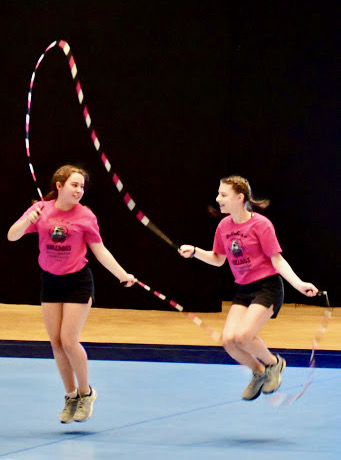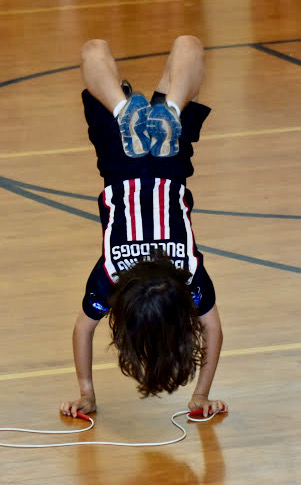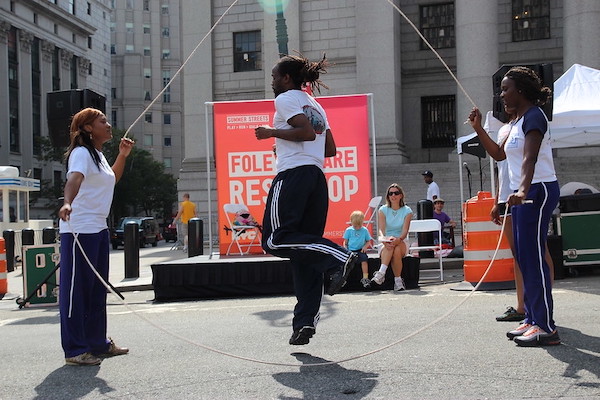NORTH CAROLINA
Jump Start
By Dalia M.
Chapel Hill, NC, United States
When most people think of jump rope they picture kids on a playground chanting rhymes. However, jump rope is anything but child’s play. It’s a competitive sport in over 38 countries.
Origin
Nobody knows for sure how jump rope began. Some reports say it originated in Egypt around 1600 BCE when athletes used it as part of their conditioning routine. What type of material do you think was used for this rope? You’d be correct if you guessed vines.
Other accounts place the first rope jumpers in Australia, China, or Japan. They could have been Aborigines, soldiers, or children.
Growing Popularity
 In the United States, immigrants from the Netherlands introduced jump rope as a game mainly for boys. The vigorous activity was considered unsuitable for girls until the 19th century. The French artist Pierre-Auguste Renoir painted a girl holding a jump rope in 1876.
In the United States, immigrants from the Netherlands introduced jump rope as a game mainly for boys. The vigorous activity was considered unsuitable for girls until the 19th century. The French artist Pierre-Auguste Renoir painted a girl holding a jump rope in 1876.
Beginning around the Great Depression, jump rope grew in popularity. During the 1940s and 1950s, a common sight was children jumping on sidewalks and in playgrounds, inventing chants, acrobatics, and contests.
In the 1970s, jump rope caught on as a type of exercise. Fitness instructors incorporated it as a cardio component to workouts. Coaches encouraged athletes to jump rope for coordination. Nowadays, physical therapists even prescribe jump rope to build strength and balance.
Varieties
Forms of jump rope range by rhythm, type of rope, and the number of jumpers participating at the same time. Here are four popular styles:
- single rope (one jumper with one rope)
- long rope (two turners with one rope)
- Chinese Wheel (two jumpers with two ropes)
- Double Dutch (two turners with two ropes and at least one jumper)
Single rope is the basic technique most people use because it is the quickest to master. Standing on both feet, you jump over the rope while swinging it under your feet and then in a big loop over your head. Once you’ve established a rhythm you can easily keep going.
 Chinese Wheel, also known simply as wheel, originated in, you guessed it, China. This style has two jumpers with two individual ropes. The jumpers stand beside each other. Instead of the jumpers holding both ends of their own rope, they hold the outside end of their own and the inside end of their partner’s rope. The ropes are turned like bicycle pedals. When one is overhead, the other is underfoot. If it sounds complicated, it is! The two jumpers must have excellent communication.
Chinese Wheel, also known simply as wheel, originated in, you guessed it, China. This style has two jumpers with two individual ropes. The jumpers stand beside each other. Instead of the jumpers holding both ends of their own rope, they hold the outside end of their own and the inside end of their partner’s rope. The ropes are turned like bicycle pedals. When one is overhead, the other is underfoot. If it sounds complicated, it is! The two jumpers must have excellent communication.
Double Dutch style originated when settlers from the Netherlands brought the game to New York City in the 17th century. It has two ropes and requires a minimum of three people: two turners and one jumper. Up to four people can jump if the ropes are long enough. The turners hold the ropes at each end and control movement and speed. They rotate the ropes inward at opposite times in a motion that looks like they are drawing two big circles.
In Double Dutch, the ropes’ paths cannot cross each other. Instructors tell new turners to pretend there’s a wall in the middle of their bodies so that each arm stays on either side of the wall. Jumpers in the ropes hop over them as they touch the ground.
The Bouncing Bulldogs
One of the places where jump rope has gained a foothold is in Chapel Hill, North Carolina. Physical education teacher Ray Frederick had a passion for the sport and wanted to invite children of all ages to have fun learning it. To realize his vision, he founded the Bouncing Bulldogs in 1986. The team now has approximately 130 jumpers in grades pre-kindergarten through high school.
Coach Frederick’s motto is “Every child is worth it,” meaning no matter what age you are or where you come from, you can learn jump rope. The Bouncing Bulldogs approach strives to help jumpers not only become skilled athletes but excel in life as well. Ten core values provide guidance:
- discipline
- respect
- teamwork
- leadership
- attitude
- perseverance
- trust
- time management
- growth
- communication
 In addition to offering classes and workshops, the Bouncing Bulldogs participate in competitions all over the globe. Their hard work has been rewarded with many wins, including six US Grand National Championships.
In addition to offering classes and workshops, the Bouncing Bulldogs participate in competitions all over the globe. Their hard work has been rewarded with many wins, including six US Grand National Championships.
Competitive jump rope has grown tremendously over the past three decades. It is among the 41 sports recognized by the Amatuer Athletic Union. Given the complexity and athleticism of jump rope, it has a chance one day to be an Olympic sport!
Single Rope Speed Events
If you choose to attend a jump rope competition, one of the events you might enjoy is called single rope speed. It involves one jumper and one rope that can be made of plastic, beads, or thin wire. The jumper tries to get as many jumps as possible during a certain amount of time. This style is similar to running in place, making sure to bring your feet up to clear the rope.
Judges at a competition count one jump every time the athlete’s right foot hits the ground. Jumpers need to practice and train intensely in order to excel at speed events. They need to consider how to pace themselves to get the most jumps in during the allotted time.

For example, one event is three minute speed. It is one of the more difficult events due to the endurance and strength required. Try running in place as hard as you can for three minutes (min.) straight and you’ll get an idea of how demanding it is.
A common training technique is to find the number of jumps you should be hitting at certain time intervals, called splits. For example, your goal might be 400 jumps in 3 min. If you jump 67 times during each 30-second interval then you would reach 402 jumps in 3 min.
Those two extra jumps are good because you might miss one or slow down towards the end. However, if you’re training for a shorter event like 30 second speed you might be more likely to go as fast as you can since you don’t need to maintain the speed for as long.
Now that you know a little bit more about jump rope, why don’t you grab a rope and try it at home? And just be glad you don’t have to use vines!
Have a suggestion for this story? We’d love for you to submit it!


Blank
Blank
Math Resources
- You’re training for the 3 min. single rope speed event. Find splits to guide your progress. If your goal is to hit 360 jumps, how many should you hit at the 1 and 2 min. mark? How about every 30 seconds?
- During a training session, you hit 55 jumps every 30 sec? What is your overall total of jumps after 3 min. provided you don’t miss any?
- During the 3 min. event, if your total score was 300, how many jumps did you get per second?
- If your score was 75 jumps in 30 seconds, how many jumps did you get per second?
- Your next event is called 2 by 60 where two jumpers jump for 1 min. each. If your goal is to hit 300 total, and one jumper is faster than the other, what are different combinations each jumper could hit?
- If a jumper hits 160 what does the other jumper have to hit to get a score of 320?
Social Justice Questions
- How do you determine what activities qualify as a sport? In your opinion, does jump rope qualify as one?
- Despite the athleticism required to be a competitive jumper, jump rope has not yet gained widespread recognition as a sport. How do you explain that lack of acceptance? Given that jump rope is primarily for girls, do you think gender might play a role?
Explore Further
- Video of Bouncing Bulldogs at the world championship competition
- Compilation video of jump rope tricks
- National Double Dutch League website
- USA Jump Rope website
- International Jump Rope Union website
Share Your Story
Write your own Global Math Story and send it to us!
Sorry, the comment form is closed at this time.